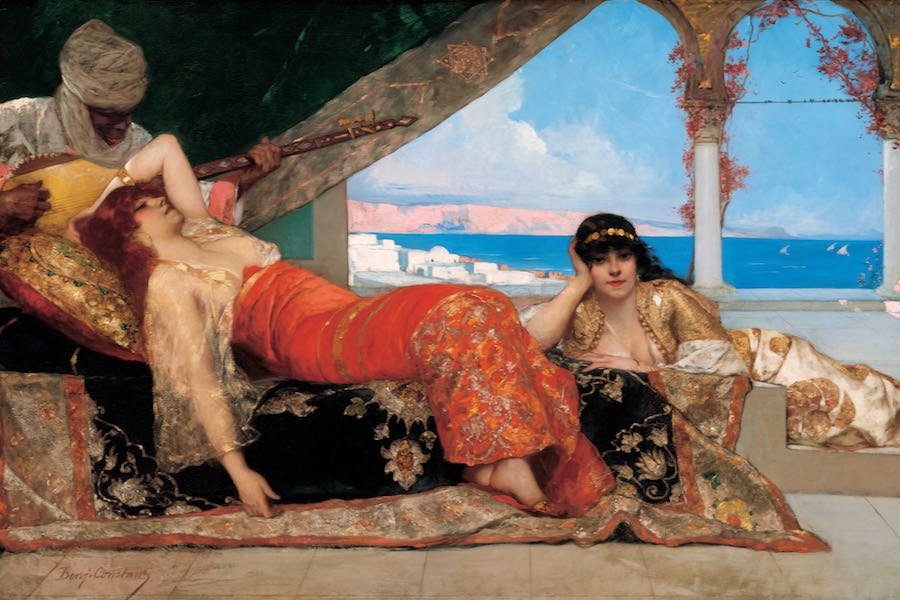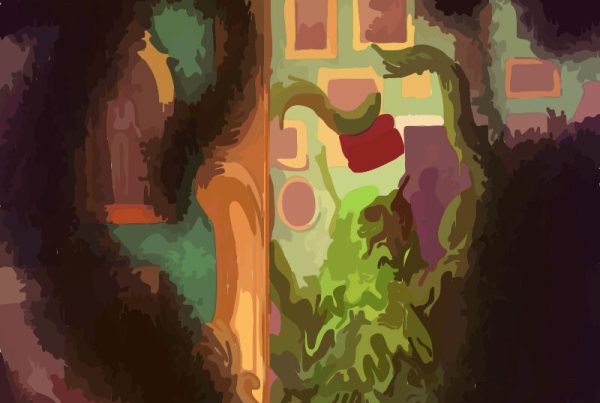Hind bint Al-Nu’man is a wildly unknown name. Imaginary character, romantic heroine, she was the first lesbian of Arabic medieval literature.
Girl power in the tenth century
Hind bint Al-Nu’man appears in a text of vulgar era written at the end of the tenth century, an erotic essay with the title: “Encyclopedia of Pleasure”. It is about a princess, the daughter of the last Lakhmid king of Al-Hirah, a small reign in today’s Iraq, who was also a vassal of the Sassanid Empire.
Al-Katib, the author of this essay, narrates the long and beautiful love story of Hind and Al-Zarqa -a girl from the central Arabian Peninsula, well-known for her beauty and magic gifts. When Al-Zarqa dies, Hind mourns her and has a cloister built in her name. “Her loyalty was an example celebrated by poets” writes Al-Katib. After him, many other authors resume this story. They insist not only on their love, but also on the fact that it is stronger than the love between a man and a woman.
It is absolutely impossible to prove the historical accuracy of this anecdote. In Arabic literature, the pre-Islamic era (Jahiliyya) is seen as a period of ignorance and disorders, well disposed to heroic ventures: thus the warrior deeds of the legendary Antar correspond to Hind and Al-Zarqa’s Sapphic loves.
A story of (female) homosexuality
Especially on this subject, people should pay attention to superficial readings. The notions of homosexuality and heterosexuality are contemporary concepts that cannot be really applied to other periods: we cannot completely talk about homosexuality during Roman times or in the Middle Ages. Nonetheless, in every period, we can find men who love men and women who love women, with the difference that men captivate occidental authorities’ attention, but women do not.

“Après le bain” – Jean-Léon Gérôme
In the medieval West, there were not words to describe two women in love. “Lesbianism” and “Sapphism” appeared only in the XIX century, when Grecian poetess Sappho was rediscovered. The most ancient term is “tribadism”, first attested in 1566 but that preserved for a long time a violent meaning. The Dictionnaire de l’Académie of 1798 still defines it as: “a woman who abuses another woman”.
On the other hand, in the Arab world there is a word: sihaq. The root of this word means “to rub” so the rigorous equivalent of tribadism, derived from the Greek verb τρίβειν. Lesbians are therefore first perceived through sexual practice.
Sahar Amer, American historian specialized on this subject, underlines that in the majority of Arabic texts, lesbians are considered from a medical point of view: women who suffer from genital itching are lesbian, a tingle that can be alleviated only by another woman’s caress. This medicalization of homosexuality will last for a very long time and it has not yet disappeared: we should remember that the World Health Organization (WHO) only in 1990 removed homosexuality from its list of psychic diseases.
A lesbian subculture in the tenth century?
Nevertheless, this medical perception is not the only one. The presence of many stories about faithful and passionate love between two women, similar to Hind’s, is evident in the Muslim world of the tenth century, A books catalogue, written in 995, reports not less than 12 texts about this topic.
In these texts lesbians are seen from a romantic and erotic point of view: different authors, from X to XII century, described veritable “lesbianism schools” in which women learned to give mutual pleasure and the authors described accessories and positions (try to imagine what “saffron massage” indicates). The success of these themes underlines that Sapphic loves are not only accepted, but also sought by the erudite public of that time.

“Bain turc” – Jean-Léon Gérôme
In few words, in Arabic medieval literature lesbianism is visible (but less relevant than heterosexual relations). Jurists considered it a sin, but not a serious one: surely far below adultery and male homosexuality (there is the same perception in the West).
Furthermore, it is evident that in this era, there is a great fluidity of genders and sexual practices in the Muslim world. Scanning through the texts, we come across women dressed as page boys with short hair and fake mustaches, many women warriors more or less in disguise, a Cordova princess that has man and woman lovers. In the “Arabian Nights” many women, among which Aluf and Zananir, bespeak to pridefully proclaim they don’t love nor desire men, they prefer women.
Princess Budur, dressed as a man, takes the place of a prince and lives with her young wife for many months. Even in this case the story focus on the love between two women and the pleasures they give reciprocally (then they start a beautiful polyamorous relationship when the real prince comes back from his journey, but this is another story). As they arrived in Occident, these tales nourish orientalist fantasy on eastern sensuality, crystallized in the harem.
Hind bint Al-Nu’man deserves to be better known. Even if she had never really existed, she remains the symbol of a time that – with ambiguity – succeeded in promoting a certain sexual liberty, extended to homosexual relations. Hind reminds us also that all is fragile. Today these texts are banned in the Arab world: in Morocco, the penisola arabica, and Egypt homosexuals are constantly arrested and assaulted. .
Unfortunately, the Middle Ages do not have the primacy of intolerance.
Bibliography
Sahar Amer, “Crossing Borders: Love Between Women in Medieval French and Arabic Literatures”, University of Pennsylvania Press 2008.
Sahar Amer, “Medieval Arab Lesbians and Lesbian-Like Women”, Journal of the History of Sexuality v. 18, n.2 (May 2009), pp. 215-236.
Francesca Canade Sautman and Pamela Sheingorn (edited by), “Same Sex Love and Desire Among Women in the Middle Ages”, Palgrave Macmillan 2001.
Florian Besson for Actuel Moyen Âge
historic at the Paris-Sorbonne University (Paris IV)
translated by Angela Maria Cicalese
©2018 Actuel Moyen Âge – Il Grande Colibrì
photos: public domain
Read also:




